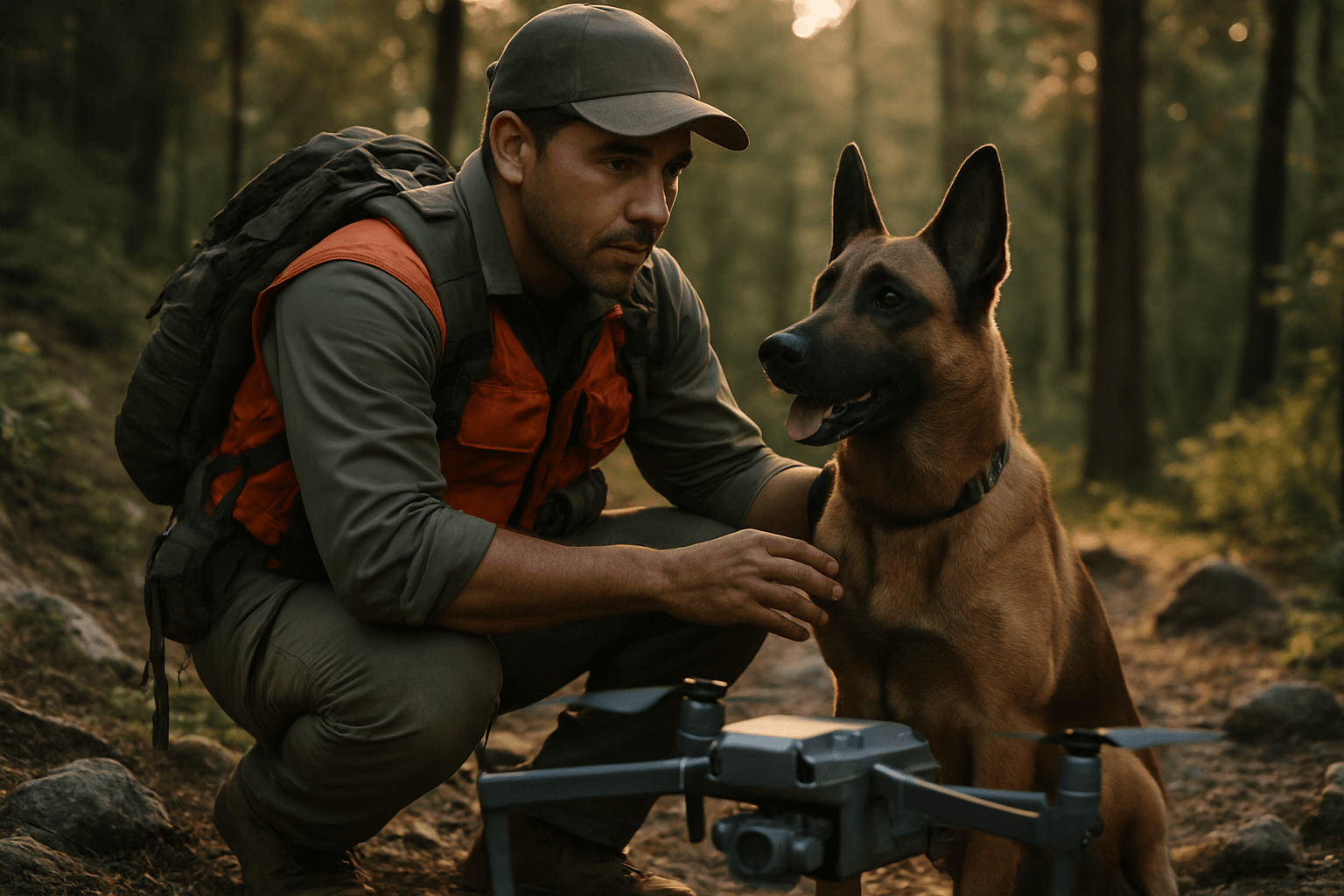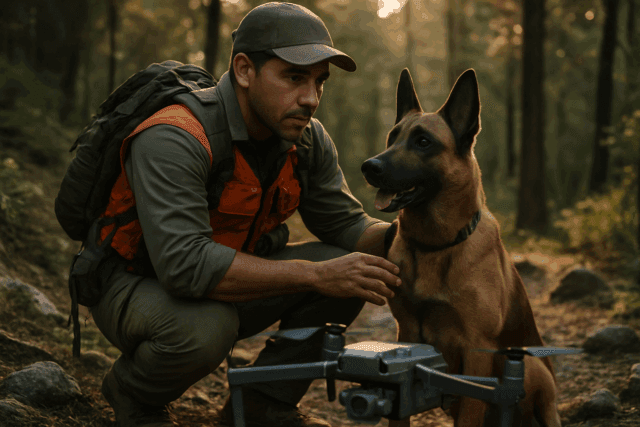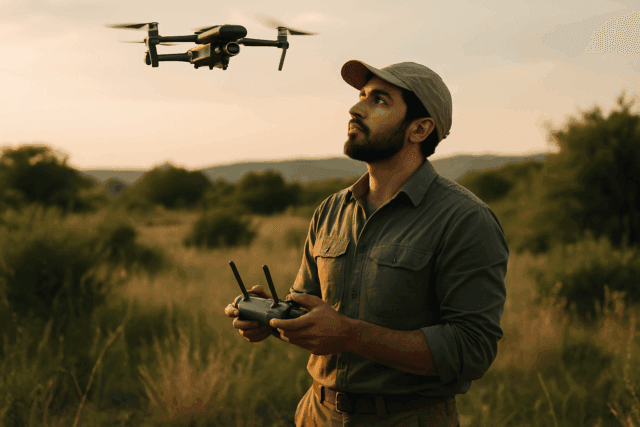In the high-stakes world of search and rescue (SAR), every second counts. Traditional methods, while invaluable, often face limitations in vast, complex, or dangerous terrains. Enter the powerful synergy of K-9 units and unmanned aerial systems (UAS), commonly known as drones. This innovative partnership is revolutionizing SAR operations, combining the unparalleled olfactory senses of highly trained dogs with the aerial perspective and advanced sensor capabilities of drones, leading to faster, safer, and more effective missions to find the lost and save lives.
The Synergistic Power of Drones and K-9 Units
The integration of drones into K-9 search and rescue operations creates a dynamic duo, each compensating for the other’s inherent limitations and significantly enhancing overall capabilities. This collaboration moves beyond simply adding a new tool; it’s about creating a more intelligent and responsive search strategy.
Bridging Gaps in Traditional Search Methods
While K-9 units are unmatched in their ability to detect human scent across vast areas, challenging environments such as dense forests, rugged mountains, or disaster zones can hinder their progress and pose risks. Drones can quickly scan large, inaccessible, or dangerous areas that would be slow or perilous for ground teams and their K-9 partners. This aerial reconnaissance helps clear sections, identify potential hazards, and prioritize areas for K-9 deployment, ensuring that the dogs are utilized most effectively where their unique abilities are truly needed.
Enhanced Situational Awareness for Handlers
One of the most significant benefits is the elevated perspective drones provide. K-9 handlers, traditionally focused on their dog’s behavior and the immediate ground environment, gain an “eye in the sky.” This overhead view offers real-time intelligence about the terrain ahead, potential obstacles like cliffs or water bodies, and even the presence of hidden individuals or suspects. This critical information allows handlers to make more informed decisions, navigate their K-9s more safely, and avoid dangers that might otherwise go unnoticed until it’s too late.
How Drones Enhance K-9 Operations
Drones contribute to K-9 operations in several crucial ways, from initial assessment to ongoing support and post-mission analysis.
Aerial Reconnaissance and Thermal Imaging
Before a K-9 team even enters a hazardous area, drones can perform swift aerial reconnaissance. Equipped with high-resolution visual cameras, they provide a comprehensive overview of the search area, allowing incident commanders and K-9 handlers to assess the environment, plan routes, and identify potential points of interest. At night or in low-visibility conditions, thermal cameras become invaluable. These sensors detect heat signatures, enabling drones to locate individuals or animals that might be hidden by foliage, darkness, or debris, guiding K-9 teams directly to a potential target.
Rapid Area Assessment and Route Planning
Drones can quickly map and survey an area, providing updated topographical information or even 3D models of collapsed structures. This data is critical for efficient search sector division, helping command centers allocate resources, including K-9 teams, to the most promising locations. The ability to identify safe paths and dangerous zones from above also minimizes the risk to both human and canine responders.
Communication and Command Support
Advanced drone systems can offer real-time live streaming of aerial footage to a command center, providing a shared operational picture for all teams involved. Some drones can also be equipped with remote speakers and microphones, allowing operators to communicate with ground teams, give instructions, or even reassure a missing person from above. This enhances coordination and allows for dynamic adjustments to the search strategy based on unfolding events.
Key Drone Technologies for K-9 Support
The effectiveness of drones in supporting K-9 units is largely due to the sophisticated technologies they carry.
Thermal Cameras and Multispectral Sensors
Thermal cameras are perhaps the most game-changing technology for SAR drones, especially for finding missing persons in challenging conditions. They detect infrared radiation (heat), allowing operators to “see” through darkness, smoke, and some types of foliage. Multispectral sensors can provide additional data about the environment, which might be useful in identifying disturbed ground or other subtle clues.
High-Resolution Visual Cameras with Zoom
Standard high-definition cameras provide clear visual feedback, essential for daylight operations. Zoom capabilities allow operators to investigate areas of interest more closely without needing to fly the drone dangerously low, which can be crucial for identifying small clues or assessing the condition of a subject.
GPS and Advanced Navigation Systems
Precise GPS and robust navigation systems are fundamental for drones to operate safely and effectively. They enable accurate mapping, allow for programmed flight paths (grid patterns), and help track the drone’s position relative to K-9 teams and points of interest.
Remote Speaker and Microphone Payloads
As seen in some real-world applications, drones with integrated speakers can deliver commands to K-9s or direct human searchers on the ground. Microphones can help detect sounds from a missing person, providing additional sensory input from the air.
Training and Integration Challenges
While the benefits are clear, successfully integrating drones with K-9 units requires meticulous planning, specialized training, and a deep understanding of both technologies.
Pilot Proficiency and Team Coordination
Drone operators supporting K-9 teams need specialized training that goes beyond basic piloting. They must understand K-9 behaviors, search patterns, and the critical information handlers require. Joint training exercises are essential to refine protocols, build trust, and ensure seamless communication and coordination between drone operators and K-9 handlers.
Canine Acclimation to Drone Presence
Dogs, with their acute hearing, can be distracted or stressed by the sound of a drone. Early conditioning of K-9s to the presence of drones, including the buzzing sound they create, is crucial. Training should involve flying drones around dogs from a young age and gradually increasing proximity, ensuring the dogs can perform their tasks without distraction. Establishing clear take-off and landing zones away from the immediate search area also helps.
Regulatory and Operational Considerations
Operating drones in SAR missions involves navigating airspace regulations, ensuring flight safety, and managing battery life for extended searches. Agencies must also develop clear standard operating procedures for drone deployment alongside K-9 units, addressing everything from communication protocols to data management.
Real-World Impact and Future Potential
The combination of K-9 units and drones is already making a tangible difference in search and rescue worldwide.
In France, the Indre et Loire Departmental Fire and Rescue Service has successfully integrated drones with canine teams, utilizing elevated perspectives and thermal imaging to enhance efficiency and safety in challenging terrains. The West Chicago Fire Department and several other Illinois fire departments have teamed up to combine K-9 and drone capabilities, leveraging thermal imaging to find missing persons and guide K-9 teams out of harm’s way. In Ottawa County, a sheriff’s drone and K-9 team successfully tracked down a fleeing suspect after a violent home invasion, demonstrating rapid response and effective coordination. A case study involving the Florida Highway Patrol also highlighted the use of drones with thermal payloads, spotlights, and speakers during a search for a missing pregnant minor, emphasizing the drones’ capability for extended night operations at lower costs compared to manned aircraft.
Looking ahead, the potential for this partnership is even greater. Research is exploring autonomous drone systems that can directly command canines without human intervention, translating handler objectives into actionable commands based on real-time observations. The future envisions integrated SAR platforms that combine drone telemetry, dog GPS tracking, handler movement data, and AI-powered alert logs into a unified command center dashboard, further streamlining operations and maximizing rescue potential. Experts predict that within the next five years, drones and dogs will be standard practice in most large-scale SAR operations.
Conclusion: A New Era of Search and Rescue
The integration of drones with K-9 units marks a significant evolution in search and rescue capabilities. By combining advanced aerial technology with the time-tested instincts of service dogs, SAR teams can operate with unprecedented speed, safety, and effectiveness. As drone technology continues to advance and training methodologies evolve, the synergistic partnership between these two powerful assets will undoubtedly continue to save more lives and bring more missing persons home.





